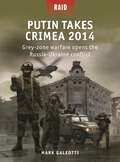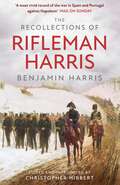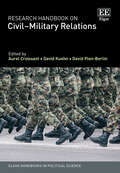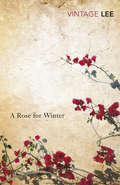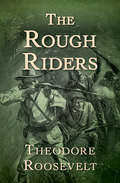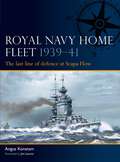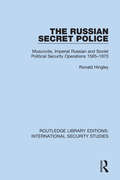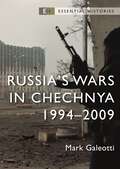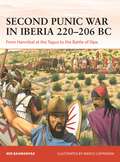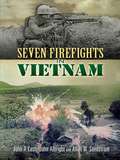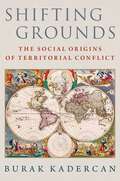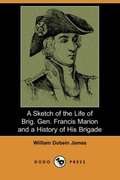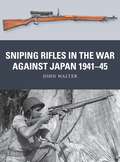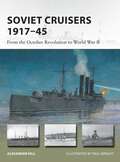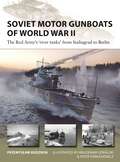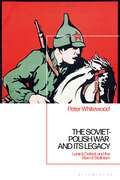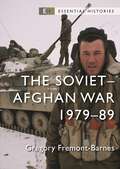- Table View
- List View
Pubs and Patriots: The Drink Crisis in Britain during World War One
by Robert DuncanIn the midst of the First World War concern arose as to the virtues of pursuing intoxication at a time of national emergency. As the military front was supposedly let down by drinkers and shirkers at home, attention quickly turned to British drinking practices. Britain, it seemed, was under the duress of a widespread addiction to boozing. When prohibition was deemed too extreme to contemplate, and nationalisation too impractical, the government created an organisation known as the Central Control Board (CCB). This body soon set about reforming the drinking habits of a nation. Loved by a few, but disliked by most, this group was responsible for the most radical and unique experiment in alcohol control ever conducted in Britain. The story of the CCB, how and why it was formed, its history and its legacy upon the British war effort are told within Pubs and Patriots: The Drink Crisis in Britain during World War One.
Putin Takes Crimea 2014: Grey-zone warfare opens the Russia-Ukraine conflict (Raid #59)
by Mark GaleottiAn authoritative analysis of how Putin's Russia conquered the Crimea in 2014 using 'grey zone' warfare techniques, blending operations by anonymous special forces with cyber, sabotage, and propaganda. Russia's annexation of Crimea in 2014 was almost bloodless – fought as much through propaganda, cyberattacks and subversion as by force of arms – but it is crucial for our understanding of both modern warfare and recent Russian history. Ironically, this slick triumph eventually led to the full-scale invasion of Ukraine, the largest and costliest conventional war in Europe since 1945. This is a fascinating account of the Crimea conquest from a supremely qualified expert on modern Russian forces. Illustrated throughout, it explores how Russia developed its new model of 'hybrid' or 'grey zone' warfare, and planned and deployed it against Crimea, from the choreographed appearance of 'spontaneous' protesters through to the deployment of unbadged Russian elite forces. In this book Mark Galeotti explores the lessons that Russia, Ukraine, and the West took from it – correctly and mistakenly – and how this apparently textbook operation sowed the seeds that would erupt so catastrophically in 2022.
Recollections and Letters of General Lee
by Robert E. LeeBiography of the famous general by his son
Recollections and Letters of General Robert E. Lee
by Robert E. LeeGeneral Robert E. Lee was the most heroic figure of the Civil War, but to many, he is a solitary figure. This book fleshes out the man and reveals the workings of a great military mind and a warm, understanding, and generous human being. It shows all the facets of the general during the war; at the conclusion, when he was an outspoken proponent of a reasonable peace which would allow the South to rejoin the Union; and after the war, when he served as president of Washington College, and became a driving force for the creation of a viable educational system. This anthology shows all these facets of the general, through his correspondence and through the revealing insight supplied by his son. No other collection of source materials gives such a whole and rewarding picture of one of the South's greatest sons and heroes.
The Recollections of Rifleman Harris (MILITARY MEMOIRS)
by Benjamin Randell Harris'Describing narrow squeaks and terrible deprivations, Harris's unflowery account of fortitude and resilience in Spain still bristles with a freshness and an invigorating spikiness' SCOTLAND ON SUNDAY'A most vivid record of the war in Spain and Portugal against Napoleon' MAIL ON SUNDAYBenjamin Harris was a young shepherd from Dorset who joined the army in 1802 and later joined the dashing 95th Rifles. His battalion was ordered to Portugal, where he marched under the burning sun, weighed down by his kit and great-coat, plus all the tools and leather he had to carry as the battalion's cobbler - 'the lapstone I took the liberty of flinging to the Devil'. Rifleman Harris was a natural story-teller with a remarkable tale to unfold, and his Recollections have become one of the most popular military books of all time.
Reminiscences of Captain Gronow
by Rees Howell GronowAnecdotes from the early 1800s by a British captain
Research Handbook on Civil–Military Relations (Elgar Handbooks in Political Science)
Bringing together leading international scholars, this comprehensive Research Handbook analyses key problems, subjects, regions, and countries in civil-military relations. Showcasing cutting-edge research developments, it illustrates the deeply complex nature of the field and examines important topics in need of renewed consideration.Arranged in five thematic sections, chapters explore the role of armed forces in politics and society, the missions and roles of militaries, and crucial issues of control, compliance and effectiveness. Contributors present theoretically informed and empirically applied research asking novel questions and examining cutting-edge solutions to ongoing problems in the field. They demonstrate the wide range of research methodologies and meta-theoretical traditions in civil-military relations, spanning structuralism, behavioralism, institutionalism, and constructivism. Ultimately, the Research Handbook is a timely insight into the contemporary role of militaries, for example in democratization and autocratization processes and deployment during natural disasters and pandemics.The Research Handbook on Civil–Military Relations will be an invaluable resource for students and scholars of military, security, and strategic studies, as well as comparative politics and military sociology. It will also be an important read for policymakers seeking to better understand the role of the military in society.
A Rose For Winter: Travels In Andalusia
by Laurie LeeAndalusia is a passion - and fifteen years after his last visit Laurie Lee returned. He found a country broken by the Civil War, but the totems of indestructible Spain survive: the Christ in agony, the thrilling flamenco cry-the pride in poverty, the gypsy intensity in vivid whitewashed slums, the cult of the bullfight, the exultation in death, the humour of hopelessness-the paradoxes deep in the fiery bones of Spain. Rich with kaleidoscopic images, A Rose for Winter is as sensual and evocative as the sun-scorched landscape of Andalusia itself.
The Rough Riders
by Theodore RooseveltTheodore Roosevelt’s bestselling memoir chronicling the 1st United States Volunteer Cavalry and its victory at San Juan Hill in the Spanish-American War. Yearning to join the fight for Cuban independence in the Spanish–American War, Theodore Roosevelt and Col. Leonard Wood formed the 1st United States Volunteer Cavalry. They enlisted a motley crew from all walks of life, from cowboys and frontiersmen to Ivy League graduates. These 1,250 men became known as the Rough Riders. After training in San Antonio, Texas, they set out for the tropical jungles of Cuba. As they grappled with hunger, malaria, and occasional defeat, their many battles with the Spanish Army culminated in the death-defying charge to victory at San Juan Hill. Through it all, Roosevelt kept a pocket diary in which he made daily entries about his experiences and the men who fought beside him. Imbued with his trademark vigor and certainty of purpose, Roosevelt’s firsthand account of this historic campaign paints a vivid picture of the rugged, independent spirit that came to define American heroism. This ebook has been professionally proofread to ensure accuracy and readability on all devices.
Royal Navy Home Fleet 1939–41: The last line of defence at Scapa Flow (Fleet #5)
by Angus KonstamPacked with illustrations, this is a new history and analysis of how the Royal Navy's most important fleet operated and fought the German Navy in the crucial first years of World War II.Throughout its history, the Royal Navy's most powerful fleet has been the one guarding home waters. In this book, naval historian Angus Konstam explores the fighting power, the roles, and the battles of the Home Fleet, in the crucial first years of World War II when it was Britain's most powerful fighting force, anchored in the northern bastion of Scapa Flow. He explains the complex responsibilities of the fleet, charged simultaneously with preventing the powerful German Navy from breaking out into the Atlantic; preparing to challenge any cross-Channel invasion force; and attacking German naval operations in the North Sea. Home Fleet actions included the loss of HMS Hood, the sinking of the Bismarck and countering the invasion of Norway, Germany's biggest amphibious operation of the war.Packed with striking new artwork and 3D diagrams and maps, this book offers a detailed portrait of the Home Fleet during these most crucial years of the war, from the capabilities of the warships to logistics and intelligence-gathering, to how the fleet was organized and commanded, and how and why it fought as it did.
The Russian Secret Police: Muscovite, Imperial Russian and Soviet Political Security Operations 1565–1970 (Routledge Library Editions: International Security Studies #18)
by Ronald HingleyThis book, first published in 1970, is an important study of Russia’s security services from their earliest years to the mid-twentieth century. Ronald Hingley demonstrates how the secret police acted, both under the Tsars and under Soviet rule, as a key instrument of control exercised over all fields of Russian life by an outstandingly authoritarian state. He analyses the Tsarist Third Section and Okhrana and their role in countering Russian revolutionary groups, and examines the Soviet agencies as they assumed the roles of policeman, judge and executioner. This masterly evaluation of Russian and Soviet secret police makes extensive use of hard-to-find Russian documentary sources, and is the first such research that studies Russian political security (Muscovite, Imperial and Soviet) as a whole.
The Russian Secret Police: Muscovite, Imperial Russian and Soviet Political Security Operations 1565–1970 (Routledge Library Editions: International Security Studies #18)
by Ronald HingleyThis book, first published in 1970, is an important study of Russia’s security services from their earliest years to the mid-twentieth century. Ronald Hingley demonstrates how the secret police acted, both under the Tsars and under Soviet rule, as a key instrument of control exercised over all fields of Russian life by an outstandingly authoritarian state. He analyses the Tsarist Third Section and Okhrana and their role in countering Russian revolutionary groups, and examines the Soviet agencies as they assumed the roles of policeman, judge and executioner. This masterly evaluation of Russian and Soviet secret police makes extensive use of hard-to-find Russian documentary sources, and is the first such research that studies Russian political security (Muscovite, Imperial and Soviet) as a whole.
Russia’s Wars in Chechnya: 1994–2009 (Essential Histories)
by Mark GaleottiWritten by a leading expert on modern Russia, this is an illustrated introduction to the bitter campaigns in Chechnya.In this new edition of his popular 2014 work, Mark Galeotti traces the progress of the wars in Chechnya, from the initial Russian advance through to urban battles such as Grozny, and the prolonged guerrilla warfare in the mountainous regions. Bringing the book up to date, including a revised introduction and new content on the Kadyrovtsy's role in Russia's other conflicts, Galeotti assesses how the wars have torn apart the fabric of Chechen society and their impact on Russia itself.Featuring full-colour maps and 50 new images, and drawing upon a wide range of sources, this succinct account explains the origins, history and consequences of Russia's wars in Chechnya, shedding new light on the history – and prospects – of the troubled region.
Second Punic War in Iberia 220–206 BC: From Hannibal at the Tagus to the Battle of Ilipa (Campaign #400)
by Mir BahmanyarThe first dedicated, illustrated study of the events of the Second Punic War in Iberia, which served as a launch pad for the Carthaginian invasion of Rome.Iberia was one of three crucial theatres of the Second Punic War between Carthage and Rome. Hannibal of Carthage's siege of Saguntum in 219 BC triggered a conflict that led to immense human and material losses on both sides, pitting his brother Hasdrubal against the Republican Roman armies seeking to gain control of the peninsula. Then, in 208 BC, the famous Roman general Scipio Africanus defeated Hasdrubal at Baecula, forcing Hasdrubal's army out of Iberia and on to its eventual annihilation at the Metaurus. In this work, military historian Mir Bahmanyar brings to life the key personalities and events of this important theatre of the war, and explains why the Roman victory at Baecula led to a strategic shift and Carthage's eventual defeat. It covers Scipio Africanus' brilliant victory at Ilipa in 206 BC, where he crushed the army of Mago Barca and Hasdrubal Gisco. Illustrated with maps, tactical diagrams, battlescene artworks and photographs, this work provides a gripping narrative of the large-scale battles fought in Iberia.
Seven Firefights in Vietnam
by John Albright Allan W. Sandstrum John A. CashBased on official U.S. Army records, these eyewitness chronicles of seven horrific battles offer an unparalleled glimpse of the day-to-day reality of the Vietnam conflict. From a fierce fight on the banks of the Ia Drang River in November 1965 to a May '68 gunship mission, these highly charged reports convey the heroism and horror of modern warfare.Each of these compelling narratives reflects events that took place throughout Vietnam after American troops were first committed in force in 1965. In addition to the achievements and sacrifices common to any war, this struggle was further complicated by an extremely elusive enemy and a new strategic dimension afforded by the helicopter--aspects that added a high degree of error, experimentation, and innovation. These accounts analyze the performance of individual soldiers under fire, illustrating both the reality of fear and the effects of military discipline and leadership.Sources for this book include daily journals, after-action reports, and official interviews that took place immediately after the battles, along with subsequent interviews and correspondence conducted by the authors. Maps and other illustrations illuminate the text.
Shifting Grounds: The Social Origins of Territorial Conflict
by Burak KadercanTerritory has always played a key role in the origins, conduct, and consequences of armed conflict. For territories to exist in any meaningful sense, human groups need to think of them in the first place, and then act upon these thoughts: territory is what states and societies make of it. In Shifting Grounds, Burak Kadercan draws upon a wide variety of cases, ranging from the Thirty Years War to ISIS, to examine the relationship between "territorial ideas" and armed conflict. He argues that states and societies have adhered to different forms of territoriality across time and space, and territory, as well as territorial control, has meant different things in different time periods and regions. Building on this premise, Kadercan makes two claims. First, how state elites conceive territory within and beyond their domains affects their military objectives as well as methods and strategies for waging war. Second, adherence to different forms of territoriality leads to different modes and patterns of war, and wars themselves may affect how state elites and societies conceive territories. Kadercan then turns to the transformative roles that wars can play in shaping dominant territorial ideas and geopolitical assumptions and how the impact of such wars differs in Western and non-Western regions. Ranging broadly across different eras and world regions, Shifting Grounds sheds light on the shifting nature of the relationship between territorial ideas and armed conflict not only in the context of the distant the past, but also in present-day global politics.
A Sketch of the Life of Brig. Gen. Francis Marion and a History of His Brigade
by William Dobein James1821 biography of Francis Marion, the lieutenant colonel in the Continental Army and later Brigadier General in the South Carolina Militia during the American Revolutionary War. <P> <P> He became known as the "Swamp Fox" for his ability to use decoy and ambush tactics to disrupt enemy communications, capture supplies, and free prisoners. His incorporation of guerilla tactics helped set the motions for later combat events in which fighting in open battlefields would decline in use. His occupation before the Revolutionary War was as a sailor. Marion is considered one of the fathers of modern guerilla warfare, and is credited in the lineage of the United States Army Rangers.
A Small Room in Clarges Street: War-Time Lectures at the Royal Central Asian Society, 1942-1944
During the darkest days of the Second World War a select group of people gathered together in Mayfair to listen to a series of secret lectures organised by the Royal Central Asian Society (now the Royal Society for Asian Affairs). Lecturers and their hand-picked audience examined fast-moving events in the Middle East, Persia and Russia with the intention to propose strategies for Britain's post-war international role. The lecturers were chosen for their inside knowledge of these countries: a British General who had visited Russia's front-line held against the German invasion; an RAF officer who was in Iraq during the pro-German coup by Rashid Ali, and the subsequent defence of the Habbaniya air base; a Persian-speaking British diplomat stationed in Teheran; a Mancunian of Lebanese descent who spoke frankly about Arab hopes and fears; a Home Officer advisor sent to Moscow to inspect its fire-watching arrangements; and a Polish countess forcibly transported to a collective farm in Siberia, among others. Secrecy surrounded these lectures many of the scripts were marked 'Secret' or 'Confidential'; they were not published in the Society's Journal, and the audience was warned not to reveal the topics discussed outside the Clarges Street premises. The discussions which followed the lectures were held in the knowledge that frank views could be freely expressed, and are included in this volume. Although so much has changed in the international arena, these seventy-year old lectures, only recently rediscovered in the Society's Archives, have a peculiar poignancy and relevance in understanding today's unquiet Middle East and how war-time events and strategies were to shape post-war policy with regard to Arab nationalism and Arab unity.
Sniping Rifles in the War Against Japan 1941–45 (Weapon #88)
by John WalterFully illustrated, this absorbing study explores the evolving sniping technology and tactics employed by both sides in Asia and the Pacific during 1941–45. During World War II, both the Japanese and their Allied opponents made widespread use of snipers armed with a variety of rifles, scopes and accessories and prepared by widely differing levels of training and tactical doctrine. The challenges of fighting in a variety of harsh environments, from the Pacific islands to the vast expanses of China, prompted improvisation and innovation on both sides in the ongoing war between snipers and their adversaries. Often operating at relatively close ranges in restrictive terrain, snipers made particularly ingenious use of camouflage and deception as the fighting spread across Asia and the Pacific in the wake of the Pearl Harbor attack, while troops tasked with countering enemy marksmen had to learn the hard way how best to defeat a seemingly invisible enemy. Small arms expert John Walter considers the strengths and limitations of the rifles, scopes and accessories deployed by Japanese snipers and their Allied counterparts, as well as their different approaches to sniping tactics and training. Specially commissioned artwork and carefully chosen photographs illustrate this enthralling study of the sniping war in Asia and the Pacific during World War II.
Soldiers as Citizens: Popular Politics and the Nineteenth-Century British Military (Studies in Labour History #12)
by Nick MansfieldRank and file soldiers were not ‘the scum of the earth’ but included a cross section of working-class men, who retained their former civilian culture. While they often exhibited pride in regiment and nation, soldiers could also demonstrate a growing class consciousness and support for political radicalism. The book will challenge assumptions that the British army was politically neutral, if privately conservative, by uncovering a rich vein of liberal and radical political thinking among some soldiers, officers and political commentators. This ranges from the Whig ‘militia’ tradition, through radical theories on tactics and army reform, to attempted ultra-radical subversion amongst troops, and the involvement of soldiers in riots and risings. Case studies are given of individual 'military radicals', soldiers or ex-soldiers who were reforming and later socialist activists. Popular anti-French feeling of the Napoleonic Wars is examined, alongside examples of rank and file bravery which fostered widespread loyalty and patriotism. This contributed to soldiers being used successfully in strike breaking, and deployed against rioters or Chartist revolts. By the late Victorian period, popular imperialism was an important part of working-class support for Conservatism. The book explores what impact this had on rank and file soldiers, whilst outlining minority support for socialism.
Soviet Cruisers 1917–45: From the October Revolution to World War II (New Vanguard #326)
by Dr Alexander HillA history of the Soviet Navy's cruisers, from the opening shots of the October Revolution through to the combat they saw during World War II.The Soviet Navy of World War II boasted a cruiser fleet that was among the most eclectic to see service. In this book, noted military historian and Soviet specialist Alexander Hill explains the role of cruisers in the Soviet Navy from the dramatic days of the October Revolution of 1917 through to the struggle they fought with Nazi Germany during World War II. Illustrated throughout with rare photos and original artwork, including a cutaway of Aurora, famous for its role in the Bolshevik October Revolution, and with profiles of the key classes, this book outlines the Soviets' development of a cruiser force. Having inherited a number of cruisers from the Imperial Russian Navy, the new Soviet Navy went on to complete two unfinished Tsarist light cruisers during the 1920s. In the late 1930s, the Soviets built their first large warships, the Kirov class, and in 1940 Nazi Germany sold the unfinished heavy cruiser Lützow to the USSR. The final cruiser-sized warship to see action was the former Imperial royal yacht Shtandart, renamed Marti and armed as a minelayer, which was used in the defence of Leningrad. Researched in the main from Russian-language sources, this study explores the cruiser fleet that saw considerable action in World War II, particularly in support of the Red Army.
Soviet Motor Gunboats of World War II: The Red Army's 'river tanks' from Stalingrad to Berlin (New Vanguard #324)
by Przemyslaw BudzbonA compelling account of the heavily armed and highly mobile Soviet river gunboats which took on the Germans during World War II.Russia's enormous river system has long been its highway and, as early as 1908, the Tsar's armies were developing armoured riverboats that brought tank-like mobility, firepower and survivability to Russian battlefields.This book, the first history of these vessels in English, explains how this concept led to one of the most remarkable naval weapons of World War II, the Soviet 'river tank', or Armoured Motor Gun Boat (AMGB). Highly mobile, capable of carrying up to 20 infantrymen directly into action and providing immediate firepower from their tank turrets, machine guns or Katyusha rockets, their military value was widely recognized. They were versatile enough to be used in naval landing operations off the Gulf of Finland, the Azov Sea and the Black Sea, and their capabilities were prized by local commanders.Using meticulously researched new colour profiles, rare photos and spectacular artwork, this book uncovers the history of river warfare on the Eastern Front, and the boats that played such a key part in the fighting.
The Soviet-Polish War and its Legacy: Lenin’s Defeat and the Rise of Stalinism
by Peter WhitewoodThis detailed study traces the history of the Soviet-Polish War (1919-20), the first major international clash between the forces of communism and anti-communism, and the impact this had on Soviet Russia in the years that followed. It reflects upon how the Bolsheviks fought not only to defend the fledgling Soviet state, but also to bring the revolution to Europe. Peter Whitewood shows that while the Red Army's rapid drive to the gates of Warsaw in summer 1920 raised great hopes for world revolution, the subsequent collapse of the offensive had a more striking result. The Soviet military and political leadership drew the mistaken conclusion that they had not been defeated by the Polish Army, but by the forces of the capitalist world – Britain and France – who were perceived as having directed the war behind-the-scenes. They were taken aback by the strength of the forces of counterrevolution and convinced they had been overcome by the capitalist powers. The Soviet-Polish War and its Legacy reveals that – in the aftermath of the catastrophe at Warsaw –Lenin, Stalin and other senior Bolsheviks were convinced that another war against Poland and its capitalist backers was inevitable with this perpetual fear of war shaping the evolution of the early Soviet state. It also further encouraged the creation of a centralised and repressive one-party state and provided a powerful rationale for the breakneck industrialisation of the Soviet Union at the end of the 1920s. The Soviet leadership's central preoccupation in the 1930s was Nazi Germany; this book convincingly argues that Bolshevik perceptions of Poland and the capitalist world in the decade before were given as much significance and were ultimately crucial to the rise of Stalinism.
The Soviet–Afghan War: 1979–89 (Essential Histories)
by Gregory Fremont-BarnesA fully illustrated overview of the USSR's bloody conflict in Afghanistan and its long legacy.The Soviet invasion of its neighbour Afghanistan in December 1979 sparked a nine-year conflict until Soviet forces withdrew in 1988–89, dooming the communist Afghanistan government to defeat at the hands of the mujahideen, the Afghan popular resistance backed by the USA and other powers. Gregory Fremont-Barnes reveals how the Soviet invasion had enormous implications on the global stage; it prompted the US Senate to refuse to ratify the hard-won SALT II arms-limitation treaty, and the USA and 64 other countries boycotted the 1980 Moscow Summer Olympics. For Afghanistan, the invasion served to prolong the interminable civil war that pitted central government against the regions and faction against faction. Updated and revised for the new edition, with full-colour maps and new images throughout, this succinct account explains the origins, events and consequences of the Soviet intervention in Afghanistan, shedding new light on the more recent history – and prospects – of that troubled country.

